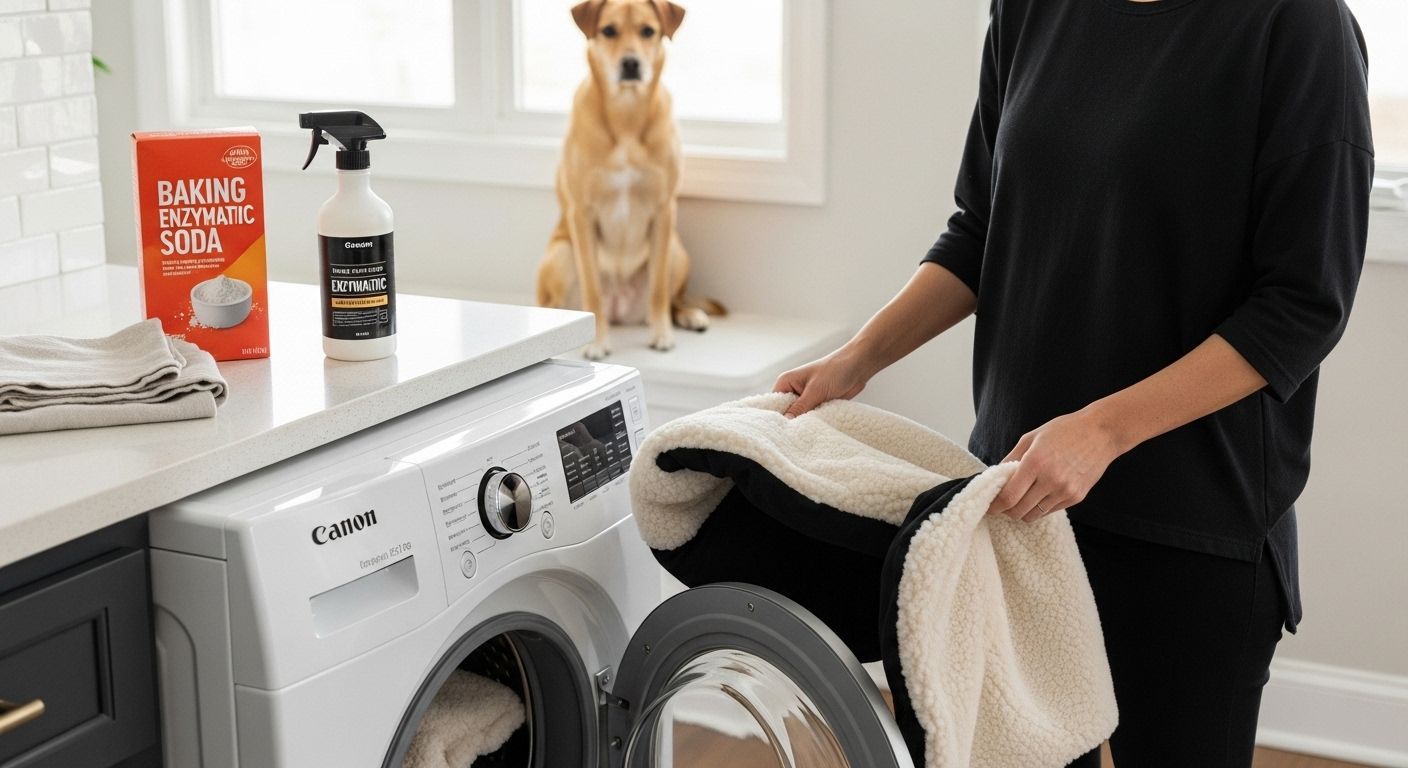Pet odors can sneak into even the cleanest homes, quietly taking over carpets, couches, and every hidden corner. Yet, most people have no idea that using a basic blacklight can reveal hidden urine stains that standard cleaning misses completely. Surprisingly, many so-called solutions only mask problems without ever tackling the true source and the right natural approach can wipe out smells so thoroughly your guests will never know you have pets. In this blog, you’ll learn how to remove pet odors naturally.
Table of Contents: How to Remove Pet Odors Naturally
- Step 1: Assess Your Current Situation
- Step 2: Gather Necessary Cleaning Supplies
- Step 3: Identify And Target Odor Hotspots
- Step 4: Clean And Deodorize Affected Areas
- Step 5: Implement Preventative Measures
- Step 6: Verify Odor Elimination And Maintain Freshness

Quick Summary
| Key Point | Explanation |
|---|---|
| 1. Identify odor hotspots thoroughly | Conduct a systematic inspection of all rooms to locate areas where pet odors are concentrated. Focus on carpets, furniture, and less-cleaned spaces. |
| 2. Gather eco-friendly cleaning supplies | Assemble natural cleaning agents like vinegar and baking soda, along with essential tools, to safely tackle pet odors without harsh chemicals. |
| 3. Clean deeper, not just surface-level | Use potent natural solutions like vinegar and baking soda to neutralize odors effectively, ensuring complete drying and multiple applications if necessary. |
| 4. Implement prevention strategies | Establish routines like regular grooming, maintaining clean pet zones, and training techniques to reduce future pet odors in your home. |
| 5. Verify odor elimination systematically | Perform detailed checks of treated areas to confirm no residual odors remain, using sensory inspection and tools like blacklights for hidden sources. |
Step 1: Assess Your Current Situation
Removing pet odors starts with a comprehensive understanding of your specific situation. Every home has unique challenges when it comes to eliminating unwanted smells, and your first task is to conduct a thorough investigation of the odor sources. Begin by walking through each room systematically, using your sense of smell to identify where pet odors are most concentrated.
Identify Odor Hotspots
Some areas are more prone to trapping pet smells than others. Focus on spots like carpets, upholstered furniture, pet bedding, and areas where your pets spend most of their time. Check corners, under furniture, and along baseboards where odor-causing particles can accumulate. Pay special attention to hidden areas that might harbor lingering smells, such as air vents, behind furniture, and less frequently cleaned spaces.
According to the Agency for Toxic Substances and Disease Registry, maintaining an odor diary can be incredibly helpful in tracking and understanding your specific odor challenges. Document the following details:
- Location of the odor
- Intensity of the smell
- Time of day when the odor is most noticeable
- Potential sources of the smell
Determine Odor Type and Severity
Not all pet odors are created equal. Some might be recent and surface-level, while others could indicate deeper issues like set-in urine stains or chronic marking behaviors. Carefully examine the affected areas for visible stains, discoloration, or signs of repeated incidents. This assessment will help you choose the most effective cleaning and deodorizing strategies moving forward. By taking a methodical approach to understanding your specific pet odor situation, you’ll be well-prepared to tackle the problem head-on in the subsequent steps of your natural odor removal process.
Here is a step overview table to guide you through each main stage of the natural pet odor removal process, including the purpose and key outcome for every step.
| Step | Purpose | Key Outcome |
|---|---|---|
| Assess Current Situation | Identify, locate, and assess pet odor hotspots | Understand problem areas |
| Gather Necessary Cleaning Supplies | Assemble safe, natural cleaning materials | Prepared for effective cleaning |
| Identify and Target Odor Hotspots | Pinpoint specific areas for focused treatment | Ensure no hidden odor sources |
| Clean and Deodorize Affected Areas | Apply cleaning solutions to remove odors | Odors neutralized at the source |
| Implement Preventative Measures | Establish habits and zones to prevent recurrence | Odors less likely to return |
| Verify Odor Elimination and Freshness | Inspect and confirm complete odor removal | Sustain fresh, odor-free home |
Step 2: Gather Necessary Cleaning Supplies
Preparing the right cleaning supplies is crucial for effectively removing pet odors naturally. Your goal is to assemble a collection of environmentally friendly and safe cleaning tools that will help you tackle odors without introducing harsh chemicals into your home. A well-organized approach ensures you have everything needed before starting the deep cleaning process.
Natural Cleaning Arsenal
Start by collecting key natural ingredients that are powerful odor neutralizers. White vinegar, baking soda, hydrogen peroxide, and enzymatic cleaners form the core of your pet odor removal toolkit. Microfiber cloths, a spray bottle, and a few clean towels will help you apply these solutions effectively. Pro tip: Choose unscented cleaning materials to prevent mixing conflicting odors.
According to the U.S. Environmental Protection Agency, minimizing volatile organic compounds is essential for maintaining healthy indoor air quality. This makes natural cleaning solutions not just effective, but also safer for your household.
Your complete cleaning kit should include:
- White vinegar
- Baking soda
- Hydrogen peroxide
- Enzymatic cleaner
- Microfiber cloths
- Spray bottles
- Clean towels
- Protective gloves
- Bucket
If you’re looking to streamline your cleaning supply organization, check out our guide on organizing cleaning supplies to keep your natural cleaning arsenal neat and accessible. Remember that having your supplies ready and organized will make the odor removal process smoother and more efficient.
To help you prepare for odor removal, here is a table summarizing the key natural cleaning supplies needed, along with their main purposes.
| Item | Purpose |
|---|---|
| White vinegar | Neutralizes odors and breaks down bacteria |
| Baking soda | Absorbs moisture and eliminates smells |
| Hydrogen peroxide | Disinfects and helps remove persistent odors |
| Enzymatic cleaner | Targets organic matter, especially pet urine |
| Microfiber cloths | For applying solutions and blotting surfaces |
| Spray bottles | Evenly distributes cleaning mixtures |
| Clean towels | For drying and absorbing excess moisture |
| Protective gloves | Shields hands from cleaning agents |
| Bucket | Useful for mixing and carrying solutions |
Step 3: Identify and Target Odor Hotspots
Identifying pet odor hotspots requires a systematic and strategic approach that goes beyond simple surface cleaning. Precise detection is crucial for eliminating odors effectively. Think of this process as detective work where your goal is to uncover and neutralize the source of persistent smells throughout your living space.
Begin by conducting a comprehensive inspection of areas where your pets spend the most time. Carpets, upholstered furniture, pet bedding, and less frequently cleaned spaces like corners, air vents, and baseboards are prime locations for odor accumulation. Use both your sense of smell and visual inspection to locate potential problem areas. Important tip: Dark or discolored spots might indicate deeper odor issues that require more intensive treatment.
According to the Agency for Toxic Substances and Disease Registry, documenting your odor investigation can help track and address persistent smells more effectively. Your inspection should include the following targeted examination points:
- Carpet fibers and padding
- Wooden or tile floor surfaces
- Fabric furniture and cushions
- Pet sleeping and playing areas
- Hidden spots behind furniture
If you’re dealing specifically with carpet odors, our guide to choosing the best carpet cleaning solution for pets can provide additional insights. When examining each area, use a blacklight if possible to reveal hidden urine stains that might not be visible to the naked eye. These invisible markers can help you pinpoint exact locations requiring deep cleaning and odor neutralization. Pay special attention to spots where your pet might have had accidents in the past, as these areas can harbor persistent odors even after initial cleaning attempts.
Step 4: Clean and Deodorize Affected Areas
Cleaning and deodorizing pet odor hotspots requires a methodical and patient approach that goes beyond surface-level treatment. Thorough cleaning is essential to completely eliminate odors and prevent future recurrence. Your goal is to neutralize odors at their source using natural, environmentally friendly techniques that are safe for both your pets and your household.
Begin by preparing a powerful natural cleaning solution using white vinegar and water. Mix equal parts of these ingredients in a spray bottle, creating a potent yet gentle cleaning agent that breaks down odor-causing bacteria. For carpet and upholstery, sprinkle baking soda generously over the affected areas, allowing it to sit for several hours or overnight to absorb moisture and neutralize smells. Pro tip: Always test any cleaning solution on a small, inconspicuous area first to ensure it doesn’t damage the surface.
According to Consumer Reports, using strategic odor-neutralizing techniques can dramatically improve your home’s freshness. Your comprehensive cleaning process should include:
- Thorough vacuuming of all surfaces
- Targeted spot cleaning with natural solutions
- Complete drying of treated areas
- Multiple treatment applications if needed
If you’re looking for additional deep cleaning strategies, our guide on cleaning basements offers excellent techniques that can be adapted to pet odor removal. When cleaning, focus on using a HEPA filter vacuum to ensure you’re capturing the smallest odor-causing particles. After applying your cleaning solution, use clean microfiber cloths to blot and lift the moisture, avoiding rubbing which can spread the odor deeper into fabrics. Repeat the process in multiple layers for stubborn odors, ensuring each application is completely dry before the next treatment.
Step 5: Implement Preventative Measures
Preventing future pet odors requires a proactive and comprehensive approach that goes beyond simple cleaning. Consistent maintenance is key to keeping your home fresh and free from recurring pet-related smells. By establishing a strategic routine, you can significantly reduce the likelihood of odor buildup and maintain a clean, welcoming environment.
Start by creating dedicated pet zones within your home that are easy to clean and maintain. Choose areas with hard surfaces like tile or laminate floors, which are more resistant to odor absorption. Important strategy: Place washable mats or easily replaceable rugs in these areas to catch potential accidents and make cleaning more manageable. Regular grooming of your pets plays a crucial role in odor prevention. Brushing your pets frequently reduces loose fur and dander, while monthly baths with pet-friendly, odor-neutralizing shampoos can dramatically decrease unwanted smells.
According to Purdue University’s College of Veterinary Medicine, proper house training is fundamental in preventing odor issues. Your preventative approach should include consistent training techniques and strategic home management:
- Establish a regular bathroom routine for pets
- Use enzymatic cleaners for immediate accident cleanup
- Maintain frequent washing of pet bedding
- Keep litter boxes clean and well-maintained
- Implement air purification strategies
If you’re interested in more comprehensive home maintenance techniques, check out our guide on cleaning basements which offers additional insights into maintaining a clean living space. Consider investing in washable, removable furniture covers that can be easily laundered. Place odor-absorbing materials like activated charcoal or baking soda in strategic locations near pet areas to continuously neutralize potential smells. By integrating these preventative measures into your regular home maintenance routine, you’ll create an environment that remains fresh and welcoming, effectively stopping pet odors before they can take hold.

Step 6: Verify Odor Elimination and Maintain Freshness
Verifying complete odor elimination requires a systematic and thorough approach that goes beyond simple surface cleaning. Comprehensive assessment is crucial to ensure that your natural pet odor removal strategy has been fully successful. Your goal is to create a fresh, clean environment that remains consistently odor-free.
Begin by conducting a detailed sensory inspection of previously treated areas. Walk through each room systematically, paying close attention to previously identified odor hotspots. Pro tip: Close all windows and doors for at least 30 minutes before your inspection to allow any lingering odors to become more noticeable. Use your sense of smell carefully, taking breaks between rooms to reset your olfactory perception. For a more scientific approach, consider using white clothing or light-colored fabrics to detect any remaining odor particles that might cling to surfaces.
According to the Environmental Literacy Council, natural odor elimination techniques can be highly effective when applied consistently. Your verification process should include these critical steps:
- Perform a thorough visual and olfactory inspection
- Use a blacklight to detect hidden odor sources
- Test multiple areas at different times of day
- Confirm complete odor neutralization
If you’re interested in maintaining a consistently clean home, learn more about keeping a clean house with cats. Consider implementing ongoing maintenance strategies such as weekly deep cleaning, using natural air purifiers like activated charcoal or essential oil diffusers, and maintaining a regular cleaning schedule. Remember that odor prevention is an ongoing process. If you detect any remaining traces of odor, repeat your cleaning process, focusing on the specific areas that still seem problematic. Patience and persistence are key to achieving a completely fresh and clean living environment.
Tired of Stubborn Pet Odors? Trust the Professionals at E.C. House Cleaning
If you have tried all the natural techniques in this guide but pet odors still linger or keep coming back, you are not alone. Homemade solutions can work for surface issues. However, deep-set smells in carpets and upholstery often require expert attention. Persistent pet odors can cause embarrassment during visits and affect the comfort of your home.
Discover the best carpet cleaning solution for pets and see why so many Massachusetts families trust our eco-friendly process to tackle even the most challenging odors.

Do not let difficult odors rob you of confidence or comfort in your home. The E.C. House Cleaning team brings over 20 years of expertise as a fully insured, family-run company delivering deep, affordable cleaning with proven results. Schedule your free consultation today using our secure online request form and get a fresh start with services tailored to pet-friendly households. Enjoy a truly clean home—contact us now before those odors get tougher to remove.
Frequently Asked Questions
How can I identify the sources of pet odors in my home?
Start by conducting a detailed walkthrough of each room, using your sense of smell to locate odor hotspots. Look for areas such as carpets, furniture, pet bedding, and less frequently cleaned spaces. Document your findings to help target cleaning efforts.
What natural ingredients are effective for removing pet odors?
White vinegar, baking soda, hydrogen peroxide, and enzymatic cleaners are all effective natural ingredients for eliminating pet odors. These substances help neutralize odors without harsh chemicals.
How should I clean carpets and upholstery to eliminate pet odors?
Sprinkle baking soda over the affected areas, allowing it to sit for several hours or overnight. For deeper cleaning, mix equal parts of white vinegar and water in a spray bottle and apply to the stains. Blot with a clean cloth and vacuum thoroughly.
What preventative measures can I take to avoid future pet odors?
Establish dedicated pet zones with easy-to-clean surfaces, maintain regular grooming routines, and clean pet bedding frequently. Additionally, consider using air purifiers and maintaining a consistent bathroom schedule for your pets.
